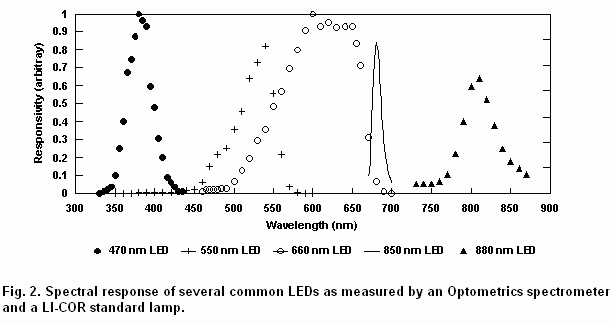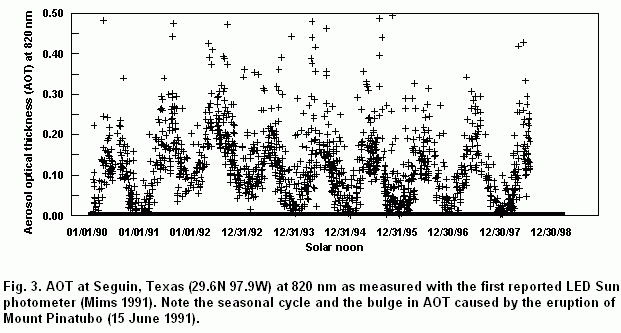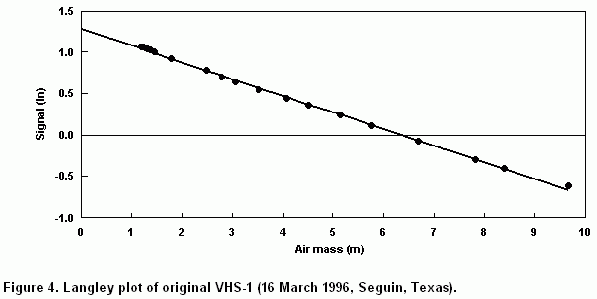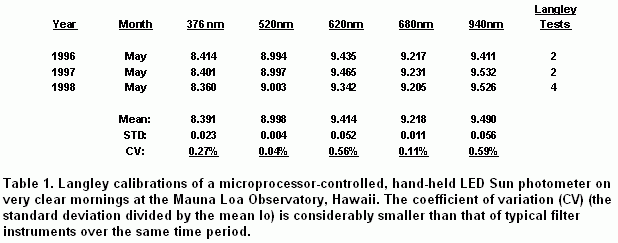
by
Forrest M. Mims III
Sun Photometer Atmospheric Network
433 Twin Oak Road
Seguin, Texas 78155 USA
fmims@aol.com
The transparency of the atmosphere plays a vital role in modulating climate. Atmospheric gases and their cargo of tiny suspended particles known as aerosols reduce the transmission of a direct beam of sunlight through the atmosphere. This reduction is known as extinction, and its magnitude is commonly expressed in terms of optical depth or thickness, a dimensionless figure of merit. Gases that significantly increase optical depth include water vapor and ozone. The most common aerosols are dust, haze, smog, smoke, volcanic emissions and clouds of water droplets and ice.
Instruments that measure the intensity in a direct beam of sunlight can measure the optical depth caused by atmospheric gases and aerosols. Pyrheliometers measure all wavelengths of the spectrum in a direct solar beam. Sun photometers incorporate filters that transmit only narrow bands within the spectrum. Sun photometers have become increasingly important due to their ability to identify specific gases and the extinction caused by aerosols. They also provide more accurate measurements than satellite instruments.
Frederick Volz introduced a hand-held Sun photometer 40 years ago (Volz, 1959). Improved versions of this instrument (Volz, 1974) were used in various networks, including 95 stations of Global Atmospheric Background Monitoring for Selected Environmental Parameters (BAPMON).
A Sun photometer should detect a relatively narrow band of optical wavelengths since the optical depth of the clear sky is strongly wavelength dependent. Optical interference filters have long been used to meet this requirement, but such filters are expensive and subject to unpredictable and very significant degradation. Filter degradation is such a serious problem that it caused the international BAPMON network to be closed and much of its 20 years of data to be abandoned as worthless (ARL, 1998). This is unfortunate, as widespread measurements of the atmosphere's transparency are important, perhaps even crucial, for testing and improving climate models.
This paper describes a new kind of inexpensive Sun photometer that provides much better long-term stability than instruments that use expensive interference filters. Pilot studies with 75 students from 16 countries at the University of the Nations in Hawaii and Switzerland and 90 science teachers in the United States have shown that a prototype version of this new instrument can be assembled and operated by non-specialists. An improved version of the prototype instrument is now being designed for the GLOBE program with the expectation it can be used to establish a broad network of reliable ground-based Sun photometers. Besides providing climate modelers with important data about seasonal aerosol variability, the proposed GLOBE Sun photometer network will provide new information about the occurrence, magnitude and transport of natural and anthropogenic aerosol events, including desert dust storms, volcanic eruptions and forest fires. Student participants will learn how to use and calibrate a Sun photometer and how to process and evaluate its data. They will also gain experience in spectroscopy, graphing, regression analysis and observational meteorology.
Although light-emitting diodes are designed to emit quasi-monochromatic light that is perceived by the eye as discrete colors, they can also detect a relatively narrow spectrum of wavelengths (Mims, 1973). Since LEDs are very rugged, stable, and inexpensive, they are ideally suited for use as spectrally selective detectors of light in portable Sun photometers.
Figure 1 compares the drift of the extraterrestrial constant (Io) measured by a filter Sun photometer from 1986 to 1990 (Pinker et al., 1994) and by an LED Sun photometer (Mims, 1993) from 1992 to 1998. The drift of the LED instrument is within +/-1.9% of the initial calibration. Though the drift of the filter instrument is an extraordinary -87.3%, its measurements form the essence of a peer-reviewed paper. The paper describes the correction of the drift, but there is no discussion about possible spectral bandpass changes that might have accompanied the filter's transmission change. Other published papers and studies have also relied on suspect Sun photometer data.

The spectral bandpass of LEDs suitable for Sun photometers ranges from about 16 to 100 nm (Fig. 2). While this exceeds the 10 nm bandpass of interference filters most commonly used in Sun photometers, preliminary comparisons of an LED and filter instrument gave similar results (Acharya et al., 1995). The responsivity of solid-state light detectors is affected by temperature. Preliminary measurements (Mims, unpublished) show that the temperature drift for various kinds of LEDs ranges from -0.15% to -0.35% per degree Celsius. These drifts are higher than those of an unbiased EG&G silicon photodiode at visible wavelengths (0% to 0.06%) and lower than that of a silicon photodiode at >950 nm (>0.30%).
The first LED Sun photometer was placed in service by Mims in South Texas (29.6 N 97.9 W) on 4 February 1990. Daily measurements at solar noon using this instrument (Fig. 3) have provided an important record of such major aerosol events as the eruption of Mount Pinatubo, significant smoke from Mexico, and major dust events from Mexico, China and Africa. Two other LED Sun photometers have measured the attenuation of sunlight caused by thick smoke from fires in Brazil (Mims, 1995 and Mims & White, 1997) and the Western United States (Mims, 1996a). One of these Sun photometers, a 5-channel microprocessor-controlled instrument, has also provided data about increased optical depth caused by pollen in Texas (Mims, 1998) and aircraft contrails in Switzerland and Alaska (Mims & Travis, 1997).
Other workers have independently confirmed the scientific utility of the LED Sun photometer. Acharya et al. (1995) concluded that LEDs are very stable detectors, and the LED Sun photometer, "…is an ideal alternative for monitoring visibility and atmospheric turbidity on any remote location on a continuous basis." Darold Ward and his colleagues at the U. S. Forest Service assembled 20 two-channel versions of the VHS-1 Sun photometer described below. African science teachers used these instruments for two months during the 1997 burning season in Zambia. This temporary Sun photometer network, the largest ever attempted, provided important new data about the geographic coverage of smoke (ZIBBEE Field Campaign Summary, 1997).
 |  |
In 1996, TERC, with support from the National Science Foundation, developed a single-channel LED Sun photometer called the VHS-1 (Visual Haze Sensor). This simple instrument can be assembled in a few hours (without soldering) inside a VHS videocassette case (Mims, 1996b). The total cost of components, which are available from RadioShack and hardware stores, is about (US). A digital voltmeter is also required.
Trials of the VHS-1 have been conducted with humanities majors from 16 countries at the University of the Nations in Hawaii and Switzerland and at three teacher's workshops in Texas and Massachusetts. These trials have demonstrated that non-technical students and teachers can quickly learn to assemble, operate and calibrate the VHS-1.
Assembly details for the VHS-1 have been published in "The Amateur Scientist" column in Scientific American (Carlson, 1997). The Concord Consortium supports the VHS-1 with an interactive site on the World Wide Web (http://concord.org/haze/). These resources have led to the construction of VHS-1 Sun photometers by students and even professional scientists. High school student Clint Beicker of Seguin, Texas is among those who have earned recognition at science fairs for their research with the VHS-1. Beicker built and calibrated a VHS-1 and then used the instrument to study the transport of haze from a thermal power plant.
Sun Photometer Calibration and Stability
Optical depth measurements require knowledge of the signal a Sun photometer would provide at the top of the atmosphere, the instrument's extraterrestrial constant (Io). Io can be inferred from calibration procedures using a standard lamp, the Sun or a previously calibrated instrument. While all these methods have advantages and drawbacks, the Sun method perfected a century ago by the Astrophysical Observatory (APO) of the Smithsonian Institution remains the most popular. This method, which was developed by Beer, Lambert and Bouguer, is often named after Samuel Langley, the secretary of the Smithsonian Institution who refined the method for APO measurements of the solar constant. The APO used the Langley method on a regular basis from about 1902 to 1963. Today the Langley method provides regular calibrations for the automated instruments of AERONET and the United States Department of Agriculture (USDA) UVB Monitoring Program. Frequent Langley calibrations are necessary due to the degradation of some interference filters used in these instruments.
Pilot studies with students at the University of the Nations have shown that the VHS-1 Sun Photometer can be easily calibrated using the Langley method. Briefly, during the morning or afternoon of a very clear day, direct Sun observations are made at frequent intervals as the Sun rises or falls in the sky. The natural logarithms of the Sun photometer signals are then plotted against the air mass during each observation. The air mass is approximately the reciprocal of the sine of the Sun's angle over the horizon (thus m = 1 when the Sun is straight overhead at the zenith). If the sky remained clear during the entire observing period, the points should fall along an almost perfectly straight line. Extending this line to the zero air mass gives the instrument's extraterrestrial constant (Io), the signal the instrument would indicate at the top of the atmosphere. The line can be extended using graph paper. A better method is to use the linear regression function of a scientific calculator or a computer and spreadsheet or curve-fitting software to solve the equation for a straight line, y = a + bx, when x = 0.
Figure 4 shows a Langley calibration plot of the prototype VHS-1 (Mims, 1996).

The GLOBE program must use stable, long-lived instruments if its data are to be of use to students and scientists. The stability of the LED Sun photometer can best be appreciated by comparing the history of conventional filter Sun photometers with results of ongoing LED Sun photometer studies.
Hand-held, two-channel Volz Sun photometers were used in the international BAPMON aerosol network. Begun in 1968, BAPMON was sponsored by the World Meteorological Organization (WMO) and the Global Environmental Monitoring System (GEMS) in cooperation with the United States National Oceanic and Atmospheric Administration (NOAA) and the Environmental Protection Agency (EPA). Significant problems due to degradation of the filters used in BAPMON Sun photometers were eventually recognized. Trijonis et al. (1990) described the degradation problem and recommended that, "The turbidity network should be improved and upgraded with stable instruments." In 1991 the WMO concluded, "The lack of success with many previous efforts to accomplish this task, routinely, must be acknowledged and deficiencies corrected by any future effort to help assure satisfactory results" (WMO, 1991). NOAA's Atmospheric Research Laboratory (ARL), which led the expert review of the BAPMON Sun photometer network, reported that, "…the sunphotometer network has been shut down. In brief, the instruments employed filters that drifted with time, and calibration requirements were therefore too much for the network to handle" (ARL, 1998). During a recent inquiry (20 July 1998), a representative of the National Climate Data Center strongly discouraged the use of archived BAPMON data.
Recently two kinds of very expensive, automated Sun photometers have been used in new aerosol networks, including AERONET, the USDA UVB Monitoring Program and the Atmospheric Radiation Measurement (ARM) Program created by the Department of Energy. Both instruments use interference filters, and both have experienced filter degradation problems that plagued earlier Sun photometers. For example, consider this recent assessment of a Multi-Filter Rotating Shadowband Radiometer (MFRSR) (ARM, 1998):
"At this time (11 March 1998) the calibration of the MFRSR is problematic. For some channels (i.e., wavelengths), the calibration drifts significantly with time. For other channels the calibration is stable but not very accurate; in some cases, the error in the spectral fluxes may be as much as 50%. The poor calibrations affect some of the flux measurements but do not affect any of the optical depths derived from the MFRSR….[?] The laboratory calibration of the instruments is problematic…[I]t appears that some calibration factors can be in error by as much as 30%. The user of the MFRSR flux data should be aware that some of these data may not be very accurate…."
A concise account of how the filter problem has affected the Cimel automated Sun photometers of the AERONET network is given by Holben et. al (1998): "With respect to the long term stability of the calibration coefficients, the optical interference filters are the limiting factors. The results are typical for interference filters. On average, there has been a decrease from 1 to 5% per year and, after 2 years, there has been a rapid decay in some filters." Holben is now experimenting with a new kind of very expensive filter that appears to provide better stability.
Three LED Sun photometers placed in service by Mims in 1990, 1992 and 1996 have demonstrated much better stability than comparable filter instruments. Two of these Sun photometers have been calibrated at the Mauna Loa Observatory (MLO) in Hawaii each year since, respectively, 1992 and 1996. Annual tests of the first instrument show that its calibration stays within a few percent of the mean rather than drifting significantly downward as with filter instruments (see Fig. 1). Much better results have been obtained with a 5-channel, microprocessor-controlled LED Sun photometer with a better designed alignment means. Table 1 shows the MLO calibrations of this instrument. A slight misalignment of the 620-nm channel contributes to its higher CV. The similar CV of the 940 nm channel is attributable to this channel's high sensitivity to water vapor.

Pilot studies at the University of the Nations in Hawaii and Switzerland and several teacher workshops have demonstrated that students and teachers can construct, operate and calibrate a simple LED Sun photometer called the VHS-1. Experience gained with the VHS-1 will lead to a family of improved instruments suitable for use by GLOBE participants. When properly used, these instruments should provide optical depth data at least as valid as that acquired by much more expensive instruments.
Specifications for a GLOBE Sun photometer are now being developed (Brooks et al., 1998). Prototype versions of this instrument will be carefully evaluated, and their observations will be compared with those from various Sun photometers. Effects of spectral bandpass, various fields of view and temperature drift are now being evaluated. Periodic Langley calibrations will be continued at the Mauna Loa Observatory and other very clear sites. Simultaneous comparisons of microprocessor-controlled LED and filter Sun photometers installed in the same enclosure will be conducted. Results of these studies will be submitted to peer-reviewed journals.
The success of LEDs in Sun photometry has led to other applications. Daily measurements of global (full sky) and diffuse solar irradiance using a radiometer with 5 LED full-sky irradiance probes began on 30 April 1996. LEDs can also be used in a simple polarimeter suitable for measuring skylight polarization, and measurements with an LED polarimeter were begun in Texas on 21 October 1996. The LED radiometer and LED polarimeter have been used during burning season in Brazil (Mims, 1998) and at the Mauna Loa Observatory.
LEDs can be used as detectors for transmission, reflectance and absorption spectroscopy (Mims, 1993). Mia Spengler, a student at the University of the Nations, confirmed unpublished work by Mims by using a desk lamp and an LED to measure the green light transmitted by leaves and other objects (Spengler, 1998). Ongoing work based on these novel applications for LEDs as detectors will lead to a family of student instruments that are potentially as stable and inexpensive as the LED Sun photometer.
This work has benefited from stimulating conversations with Frederick Volz, John DeLuisi, Brent Holben and many other specialists. Robert Tinker and Barbara Tinker have enthusiastically supported the VHS-1 Sun photometer project, originally through TERC and now the Concord Consortium. I thank Shawn Carlson for describing the VHS-1 in Scientific American. Finally, I very much appreciate the many teachers in the U. S. and my enthusiastic international students at the University of the Nations (U. of N.) in Hawaii and Switzerland who have assembled and tested many VHS-1 Sun photometers. I especially appreciate the work of John Kuhne, Dean of Science at U. of N., and students Cindy Sigamoney (South Africa) and Brian Maxwell (USA), whose assembly and tests and Langley calibrations of the first three independently constructed VHS-1's established the viability of a simple student Sun photometer.
Acharya,Y. B., A. Jayaraman, S. Ramachandran, and B. H. Subbaraya, Compact Light-Emitting Diode Sun Photometer for Atmospheric Optical Depth Measurements, Applied Optics 34, 1209-1214, 1995).
Angione, R. J. Review of Ground-Based Measurements, Variations of the Solar Constant (S. Sona,Ed.), NASA Conf. Pub. 2191, 1981.
ARL, http://www.arl.noaa.gov.research/programs/aod.html, 1998.
ARM, Multi-Filter Rotating Shadowband Radiometer (MFRSR),
Brooks, David R., Forrest M. Mims III, Tran Nguyen & Stephen Bannasch, Characterization of LED-Based Sun Photometers for Use as GLOBE Instruments, Proceedings of the 1998 GLOBE Conference, 1998.
Carlson, Shawn, Hazy Skies are Rising, Scientific American 276, 106-107, 1997.
Holben, B. N., T. F. Eck, I. Slutsker, D. Tanre, J. P. Buis, A. Setzer, E. Vermote, J. A. Reagan, Y. F. Kaufman, T. Nakajima, F. Lavenu, I. Jankowiak, and A. Smirnov, AERONET-A Federated Instrument Network and Data Archive for Aerosol Characterization, J. Remote Sensing (in press) and http://spamer.gsfc.nasa.gov/.
Mims III, Forrest M., Light Emitting Diodes, Howard W. Sams & Co., 118-119, 1973.
---, Science Notebook: Simple Sun Photometers, Science Probe 2, 111-114, 1992.
---, Sun Photometer with Light-Emitting Diodes as Spectrally Selective Detectors," Applied Optics, 31, 6965-6967, 1993.
---, Aerosol Optical Depth, Ultraviolet-B and Total Sky Irradiance during SCAR-B (Brazil), NASA purchase order No. S-59036-Z, 1995.
---, Aerosol Optical Thickness, Total Ozone, UV-B, Diffuse/Total Solar Irradiance and Sky Polarization Through Forest Fire Smoke and Stratospheric Aerosols During TOMS Overpasses, NASA purchase order S-78417-Z, 1996a.
---, TERC Visible Haze Sensor-1 (VHS-1) Sun Photometer, TERC, 1996b.
--- and Bradley S. White, Scientific Studies During the 1997 Burning Season at Alta Floresta, Brazil, NASA purchase order S-97728-Z, 1997.
--- and D. J. Travis, Aircraft Contrails Reduce Solar Irradiance, EOS 78, 448-449, 1997.
---, Solar corona caused by juniper pollen in Texas, Applied Optics 37, 1486-1488, 1998.
Pinker, Rachel T., G. Idemudia and T. O. Aro, Characteristic aerosol optical depths during the Harmattan season on sub-Shara Africa, Geophysical Research Letters 21, 685-688, 1994.
Trijonis, J. C., Malm, W. C., Pitchford, M., White, W. H., Charlson, R. and Husar, R., Visibility: Existing and Historical Conditions--Causes and Effects, Acidic Deposition: State of Science and Technology, Rep. 24, National Acid Precipitation Assessment Program, 118, 1990.
Volz, F.E., Photometer mit Selen-photoelement zurspektralen Messung der Sonnenstrahlung und zer Bestimmung der Wallenlangenabhangigkeit der Dunsttrubung. Arch. Meteor. Geophys Bioklim. B10:100-131, 1959.
--- Economical Multispectral Sun Photometer for Measurements of Aerosol Extinction from 0.44 um to 1.6 um and Precipitable Water, Applied Optics 13, 1732-1733, 1974.
WMO, Report of the Meeting of Experts to Assess Available Data and Define the Aerosol Component for GAW-BAPMON Stations (Boulder, 16 - 19 December 1991), WMO Global Atmosphere Watch Report Number 79. WMO Secretariat, Geneva, Switzerland, 1991.
ZIBBEE Field Campaign Summary, Zambian International Biomass Burning Emissions Experiment (ZIBBEE), Meteorological Dept. of Zambia, USFS and NASA, http://spamer.gsfc.nasa.gov/zibbee/Zambia, 1997.